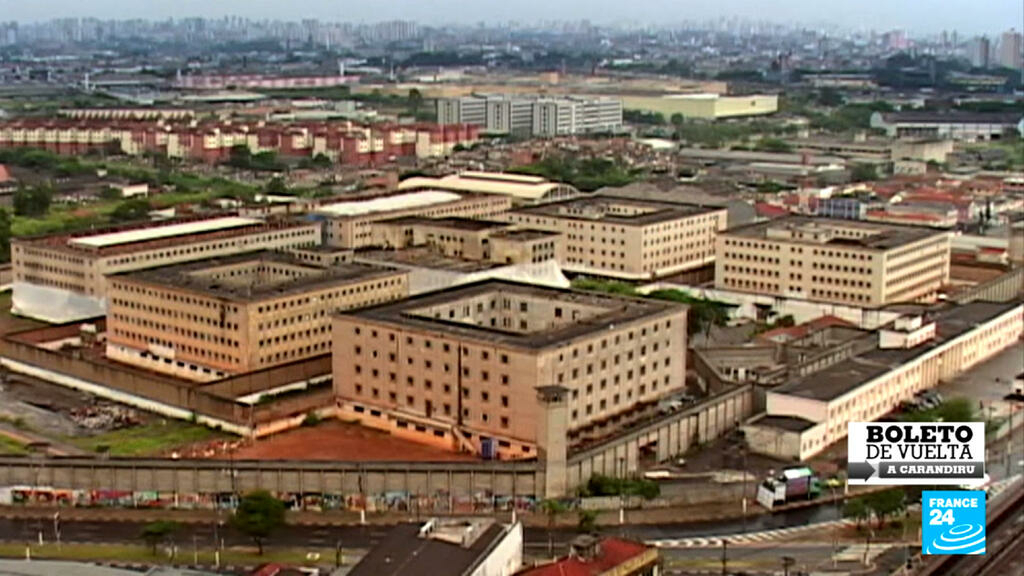On October 2, 1992, the São Paulo Police carried out the largest prison massacre in Latin America, resulting in 111 dead prisoners. It happened in the emblematic prison of Carandiru, where 8,500 inmates were crowded in inhumane conditions, on the eve of the municipal elections in the largest city in Latin America. This is the story.
“When I went out to the gallery, I saw a pile of corpses lying on the ground. This scene has been a constant in my mind. In the days after the massacre, the images of the bloody bodies tortured me psychologically at night, when I slept. I often woke up screaming, in a panic,” admits Sidney Sales, a survivor of the Carandiru massacre.
30 years later, none of those responsible for this massacre has served a sentence. After more than two decades of trials marked by slowness, in 2014 a popular jury sentenced 74 of the more than 100 accused police officers with sentences of 48 to 624 years in prison. However, in 2016 the São Paulo Court of Justice annulled all convictions. In June 2021, this same court restored the penalties, but a tangle of legal resources has prevented this legal saga from coming to an end.
The judicial dispute lies in a contradiction of versions. According to the surviving prisoners, their legal defenders and human rights organizations, the inmates had already handed over their weapons when the police entered the prison. Therefore, it would have been an unjustified execution. However, the Government of the State of São Paulo continues to defend that the agents were attacked by the prisoners and that they acted in legitimate defense.
There was no need for such an action, the inmates were already overpowered
Criminal expert Osvaldo Negrini was the first person to enter jail after the massacre. “When I arrived, to reach the first floor I had to climb a ladder: it was a waterfall of blood. The blood ran down the stairs and reached my faucet,” he recalls.
In the dossier, which he prepared together with a Civil Police photographer, Negrini reflected that the agents exceeded their brutality: 85 of the 111 victims were executed inside their cells, without offering resistance.
“Many shots were fired from the windows of the cell doors and above with a machine gun. In this way the police managed to kill four or five prisoners at once. There was no need for such an action, the inmates were already overpowered. But, it is not known for what reason they chose to exterminate several of them simultaneously”, he points out.
Negrini also showed that the Police fabricated false evidence to justify the excessive violence of the operation. “When the award came out revealing that 95% of the shots were fired into the cells, there was no longer any way to claim self-defense. Where were the shots from the inside out? There wasn’t one. Also, were the prisoners’ weapons seized? Yeah, but the weapons we delivered to the labs didn’t show any trace of a shot. Some didn’t even work, they were very old. So it became very clear that no one had used those weapons, ”he explains to France 24.
After delivering his report, this investigator received anonymous threats and had to ask for protection from the same authorities he was accusing of excessive violence.
Carandiru and his own echo of impunity
Carandiru today is not only the symbol of the violence exercised by the State against those citizens whom it should rehabilitate, but it has also become synonymous with impunity. “This massacre is the reflection of a terrible public security policy, with very high levels of incarceration and a Police that kills instead of managing social problems in another way. In fact, the Brazilian police are the ones that kill the most in the world,” says Maíra Rocha Machado, professor of Law at the Getúlio Vargas Foundation in São Paulo.
This jurist has been studying the Carandiru case for more than 10 years. For her, there was a clear attempt to cancel the vestiges of this slaughter. “The next day, they began to erase the evidence of what happened on October 2, 1992, because a massacre that occurred within the institutions of the State itself, carried out by the State police itself, is something very serious, inadmissible,” he says. she.
In December 2002, three of the seven blocks in the Carandiru prison were detonated. In a few seconds, the scene of the worst prison massacre in Latin America was literally turned to dust. In 2005, two other buildings were destroyed. In total, only two pavilions were saved from demolition. Today, in its place there is a green area that bears the emblematic name of Parque de la Juventud.
Pavilion number four, which once functioned as an infirmary, houses a technical school. There, in 2018, the Carandiru Memory Space was inaugurated, which rescues the history of this prison through hundreds of objects donated by the prisoners themselves before the structure was blown up.
The exhibition was idealized by the photographer Maureen Bisilliat over almost two decades. Its location within one of the original pavilions of Carandiru has a strong symbolism within a trajectory marked by institutional sabotage against historical memory.
Carandirú Massacre | Today, 26 years ago, the Military Police of São Paulo entered a prison to contain a riot and ended the lives of 111 people. An average of 5 shots were fired at each one and no police officers were injured. Until today there are no convicted policemen. pic.twitter.com/8VoY1AOzBQ
– Nacho Lemus (@LemusteleSUR) October 2, 2018
The Carandiru massacre represented a before and after in Brazilian prison history. After its demolition, the Government of the State of São Paulo chose to create smaller prisons far from the city, in an attempt to avoid overcrowding. It was a failed experiment that culminated in the birth of the PCC, the First Capital Command. It is the most powerful criminal organization in Brazil, which controls drug trafficking and all prisons in São Paulo with an army of at least 20,000 inmates.
The scourge of prison overcrowding, far from ending
Currently, Brazil is the country with the third largest prison population in the world and the first in Latin America. There are about 750,000 inmates. One in three was detained preventively, something that contributes to increasing overcrowding. In fact, Brazilian prisons are 55% over capacity. The main associations of relatives of prisoners denounce that little or nothing has changed since the Carandiru massacre, and that inmates suffer systematic torture and mistreatment.
“Today there is a slow slaughter. In Carandiru they exterminated 111 prisoners at one time, but today every 19 hours a prisoner dies within the Brazilian prison system. So they continue to kill, but in a different way, ”says the mother of a prisoner, who prefers to hide his identity for fear of reprisals.
“My son to this day, like many sentenced prisoners, still sleeps on the floor because he doesn’t have a bed due to overcrowding. I found my son depressed. The health of the prisoners is very precarious,” he adds.
These complaints are supported by the Public Defender’s Office of the State of São Paulo, which carries out about 40 inspections per year without prior notice. Month after month, this institution confirms that overcrowding, terrible sanitary conditions and lack of food are the rule and not the exception in the prisons of this federal state.
“During the inspections we verified that 80% of the penitentiary centers ration water. There are prisons that have water only two hours a day. Of the 179 prisons in São Paulo, none have a minimum health team. Unfortunately, prisoners fall ill and die,” says Leonardo Biagioni de Lima, Public Defender of the State of São Paulo.
This institution has also detected cases of structural torture, both physical and psychological. “Almost every day there are reports of assaults inside prisons. We already registered many images. In successive inspections we collected rubber balls and documented marks from tear gas canisters and blows, the result of the action of the rapid intervention groups inside the prisons of São Paulo”, adds Biagioni.
The legal battle intensifies
France 24 visited the José Parada Neto maximum security prison in Guarulhos, in the State of São Paulo. According to the Public Defender’s Office, 81% of the penitentiary centers in this region suffer from overcrowding.
The director André Luiz Alves said that, in the last two years, the number of prisoners fell by 13%. He also denied that there is a high mortality rate. “There really are prisoners who die, but they are very serious cases, of people who were already in treatment. Proof that there is not much mortality was the control of Covid-19 within the prison system. The rate of contamination and deaths here was much lower than on the street. Today, for example, all prisoners are vaccinated”, says Alves.
In the José Parada Neto prison there are 1,900 inmates, 850 more than its capacity allows. 430 work for one of the 13 companies that operate within its structure, thanks to a series of state programs that encourage reintegration.
Paradoxically, they make clothing and shields for the Police shock troops. “They get three quarters of the minimum wage. The 25% that is left over is placed in a general account that is used to pay the prisoners who work for the operation of the prison”, Alves points out.
For the Public Defender’s Office of the State of São Paulo, these initiatives represent an exception within the prison panorama of Brazil, collapsed by the high number of arrests. It is the result of the so-called “war on drugs”, which significantly worsened overcrowding, since the 2006 Drug Law increased the minimum prison time for any type of trafficking. Many experts criticize this public security policy. Currently, one in three Brazilian prisoners is sentenced under this law.
About to celebrate 30 years of the massacre, the legal saga seems to have no end. At the beginning of August, the Public Safety Commission of the Chamber of Deputies approved a bill that granted amnesty to military police officers who had been prosecuted or sanctioned. However, a few days later the Supreme Court intervened, which denied this appeal.
Judge Luíz Roberto Barroso rejected the defense argument that there had been a violation of the principles of contradiction, right to defense, and due process of law. The struggle between the State and Justice has intensified again. Meanwhile, it should be noted that most of the relatives of the prisoners who lost their lives never received any type of compensation.















Add Comment